How has air quality in Germany changed in the last 40 years?
Post-World War II in 1945 saw Germany divided into four zones by the Americans, the British, the French, and the Soviets. The western two-thirds of Germany, known as the Federal Republic of Germany (unofficially: FRG), consisted of the American, British, and French zones. The eastern third, under the Soviets, became the German Democratic Republic (GDR). Opposing economic, social, and political systems began to emerge in the years following the division due to the differences between the occupying powers. The discrepancy in land size, population, and natural resources between the FRG and the GDR also added to a divergence in industrialization. As a result, land, water, and air pollution quickly became an issue, particularly in the GDR. Germany’s reunification took place on October 3, 1990. Let’s take a closer look at how air quality has changed across the country since then.
What was air quality in the former East Germany (GDR) and former West Germany (FRG) like?
Air quality differed between East and West Germany. At the turn of the century, air pollution was the most pervasive problem in the GDR. This is because its primary energy source came from the burning of domestic lignite (brown coal) for heat and energy. High in sulphur and ash content, the burning of lignite thus resulted in high sulphur dioxide (SO2) and particulate matter (PM) emissions. It is estimated that total SO2 emissions in the GDR amounted to 5.8 million tons, the highest in Europe. This is stark in comparison to 3 million tons for West Germany, which had 3 times the population and 2 times the land area. The issue was particularly prevalent in the industrial Leipzig/Halle/Weißenfels/Bitterfeld region of the GDR. In the 1980s, annual sulphur dioxide levels were over 400 μg/m³. This was 4 times higher than in the West German Ruhr area, the economic powerhouse of local industries. In comparison, the highest sulphur dioxide measurements in the region are at around 10 μg/m³ today. In central Germany, annual particulate matter levels were two times higher than in the Ruhr district at values of 150-200 µg/m³.
The environmental issues from the GDR naturally also affected West Germany, as air pollution does not stop at borders. However, it was not strictly a one-way street: depending on wind conditions, SO2 and PM emissions alternated between lignite power stations in Harbke (the East) and Buschhaus (the West). In fact, SO2 concentrations have also reached over 1,000 µg/m³ in certain areas of the FRG. The difference, however, lay in government actions: the West declared smog alerts, warned the populace, cut back on industrial production, and imposed driving bans, while the East did nothing.
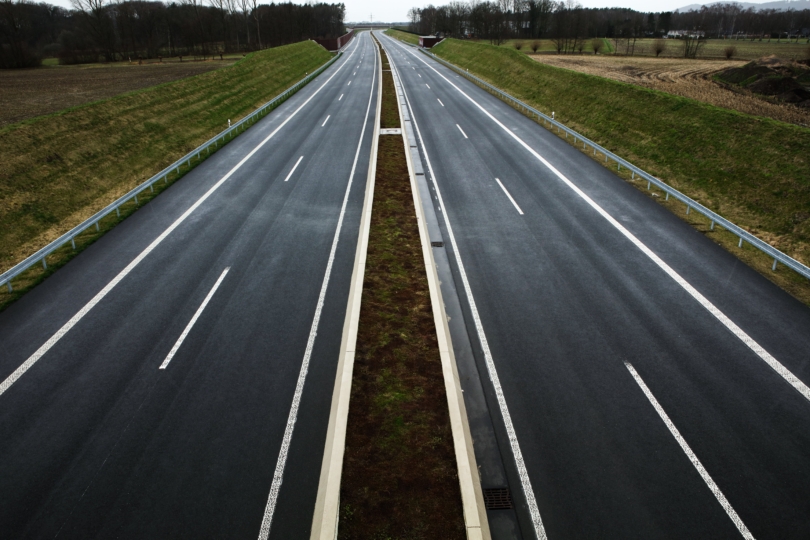
The international oil crisis of 1973 led to the banning of driving on Sundays in the FRG. This initiative was known as „Autofreier Sonntag“ in German. Image source: https://unsplash.com/photos/VBsEtYuHHSU
An environmental protection framework agreement between the East and the West was considered in late 1972, though the GDR stopped negotiations the following year. This was due to the establishment of the German Environment Agency (Umweltbundesamt – UBA) in West Berlin in July 1974, which the East considered to be a breach of the Four-Power Agreement. The clause stated that West Berlin was not part of the FRG, but acknowledged special relations with the region. While there were negotiation attempts at joint work targeting pollution issues between the FRG and the GDR, no real changes ultimately took place. In 1983, the FRG enacted the Large Combustion Plants Ordinance, which effectively limited SO2 emissions from power and industrial plants and led to a rapid and significant fall in air pollution in the west. On June 6, 1986, the FRG founded the Federal Ministry for the Environment, Nature Conservation, and Nuclear Safety (Bundesministerium für Umwelt, Naturschutz und nukleare Sicherheit – BMU). These actions would become cornerstones in implementing environmental policies and changes for a cleaner, healthier Germany come reunification.
How did air quality in Germany develop over the years?
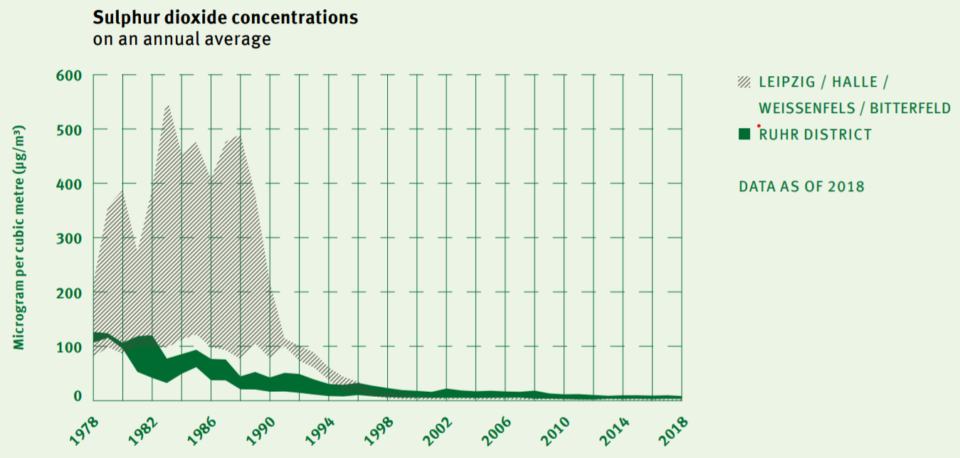
Image Source: https://www.umweltbundesamt.de/en/publikationen/what-matters-2-2020-30-years-german-unity
As previously stated, the main sources of sulphur dioxide emissions in both East and West Germany were power, heating, and industrial combustion plants and households. From the graph above, SO2 emissions remained consistently high in Leipzig/Halle/Weissenfels/Bitterfeld areas of the GDR all the way until reunification in 1990 due to the power plants lacking filter systems. In comparison, SO2 emissions in the Ruhr district of the FRG were on a constant, steady state of decline until 1990 and beyond thanks to the implementation of the Large Combustion Plants Ordinance of 1983.
What was air quality post-German reunification like?
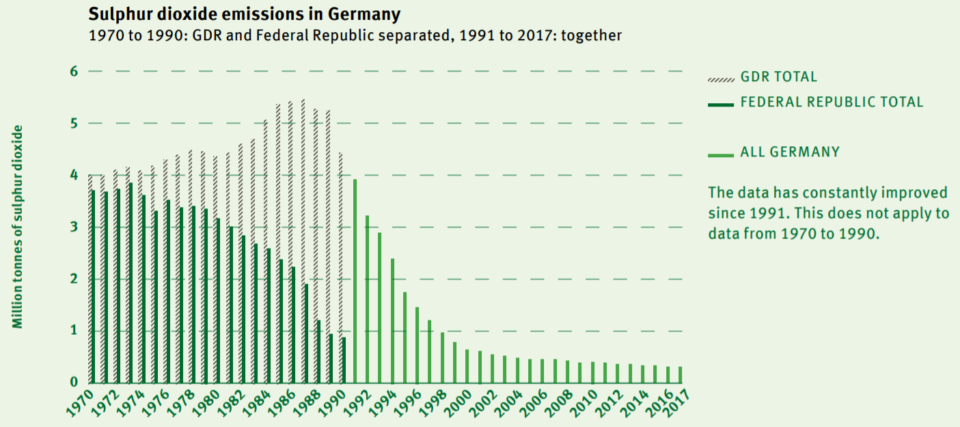
Image Source: https://www.umweltbundesamt.de/en/publikationen/what-matters-2-2020-30-years-german-unity
The social and political changes brought by the reunification of Germany in 1990 led to significant changes in air quality: sulphur dioxide emissions dropped by 60%, while particulate matter emissions dropped by 82%. This was initially caused by low demand for products and energy as a result of unification, which led to a collapse of the industrial and agricultural structure in East Germany. Later, the closing and rehabilitating of power stations and industrial plants along with a series of air pollution controls introduced between 1992 and 1996 was what ultimately drove air pollution down. These included transitioning from coal to liquid and gaseous fuels, reducing the sulphur content of coal, and retrofitting lignite power plants with flue gas desulphurization systems. It wasn’t until 2000, however, that air pollutant concentrations in both east and west Germany ceased to differ.
What is air quality in Germany like today?
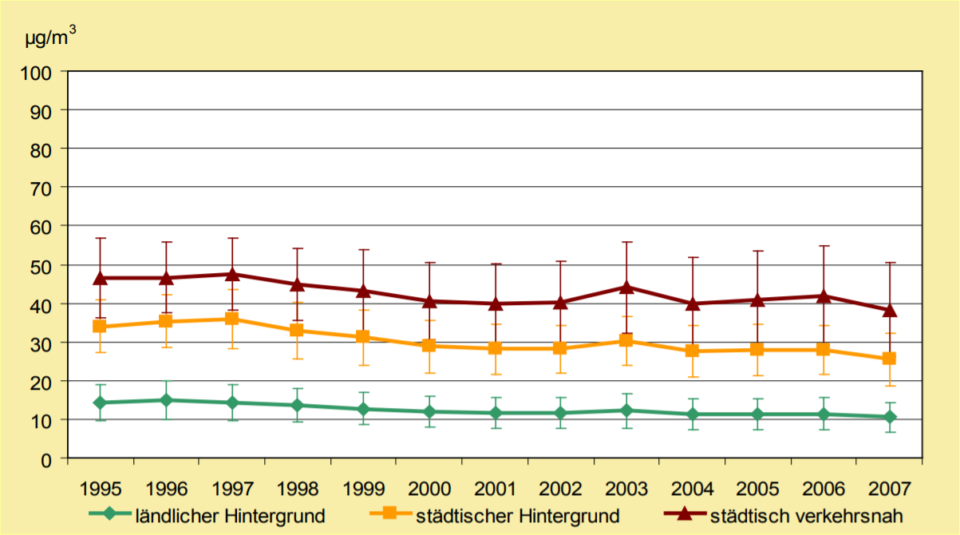
Development of the annual mean values of NO2 in Germany from 1995 to 2007. Green: Rural Concentrations. Yellow: Urban Concentrations. Red: Urban Concentrations near Traffic. Image Source: https://www.umweltbundesamt.de/publikationen/entwicklung-luftqualitaet-in-deutschland
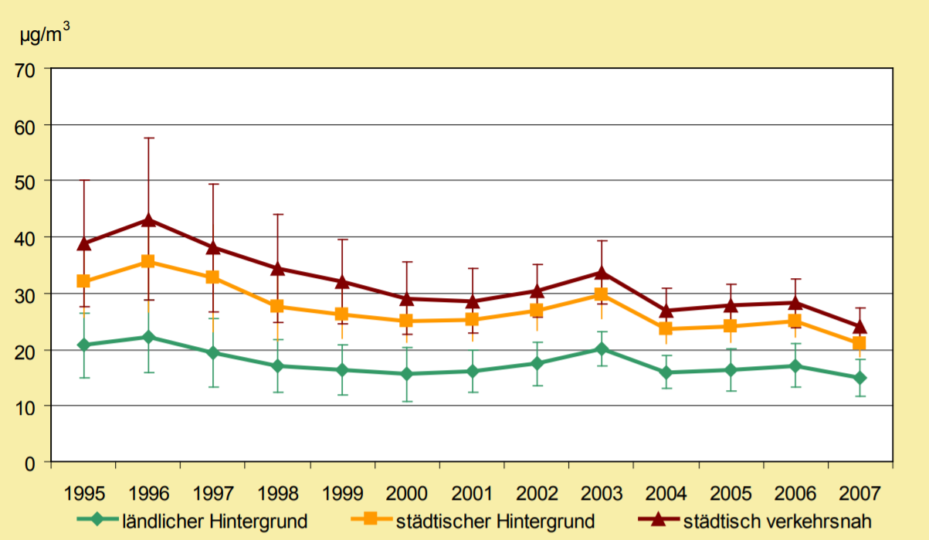
Development of the annual mean values of PM10 in Germany from 1995 to 2007. Green: Rural Concentrations. Yellow: Urban Concentrations. Red: Urban Concentrations near Traffic. Image Source: https://www.umweltbundesamt.de/publikationen/entwicklung-luftqualitaet-in-deutschland
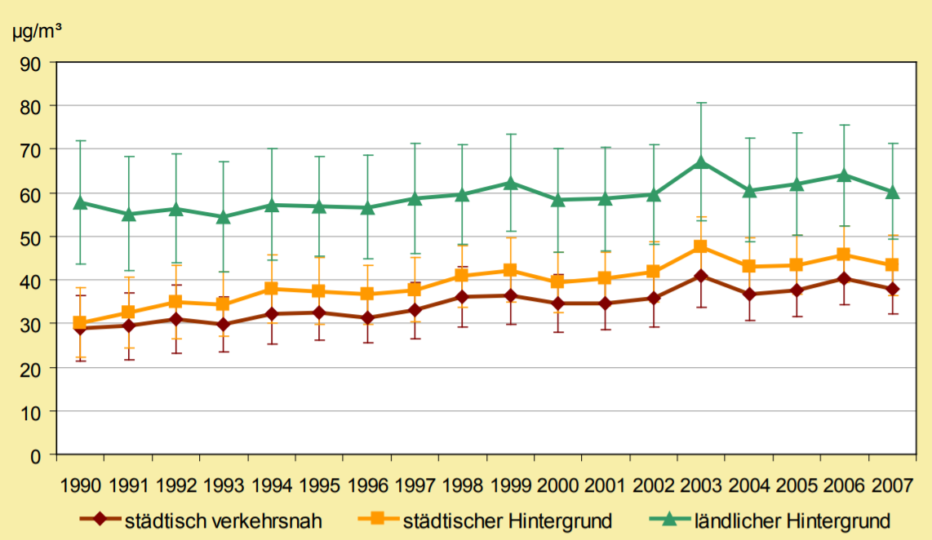
Development of the annual mean values of O3 in Germany from 1990 to 2007. Green: Rural Concentrations. Yellow: Urban Concentrations. Red: Urban Concentrations near Traffic. Image Source: https://www.umweltbundesamt.de/publikationen/entwicklung-luftqualitaet-in-deutschland
Today, nitrogen dioxide (NO2) and particulate matter (PM) pollution remain as issues in metropolitan German cities. The most recent data shows that while ozone (O3) and particulate matter (PM) limit levels were met in 2019, nitrogen dioxide remains a problem in 25 cities due to road traffic from diesel vehicles. This number is expected to drop considerably given Germany’s efforts in reducing air pollution.
The graphic above also shows that ambient ozone levels have typically been higher in the countryside than in cities. The are 3 reasons for that:
- NO2 from urban traffic reacts with sunlight and heat to form O3 during the day. At night, the presence of NO from vehicles degrades O3 back to NO2. This is known as the “ozone paradox”.
- O3 levels typically tend to be higher downwind of ozone precursor sources and are thus more concentrated in the countryside. This is because of the lack of NOx from traffic and the rapid oxidation of NO to NO2 once emitted, which makes the degradation of O3 impossible.
- Methane (CH4), a greenhouse gas (GHG) emitted by livestock contributes to the formation of O3 in rural areas.
Germany’s strategy for air pollution control is based on four pillars:
- Defining air quality standards
- Determining emission limit values based on state-of-the-art technology
- Regulating products
- Defining emission reduction commitments
The policy instruments Germany has put in place for curbing air pollution include:
- Transboundary air pollution control policy: based on Directive 2008/50/EC on ambient air quality and cleaner air for Europe, Directive 2010/75/EU on industrial emissions, and Directive 2016/2284/EU on the reduction of national emissions of certain atmospheric pollutants. These require all EU member states to reduce national emissions of sulphur dioxide (SO2), nitrogen dioxide (NO2), non-methane volatile organic compounds (NMVOC), ammonia (NH3), and primary particulate matter (PM2.5) by 2030.
- The National Clean Air Programme: this was adopted by the German government on May 22, 2019 to meet the National Emissions Ceilings (NEC) Directive (2016/2284/EU) for Germany
- Federal Immission Control Act (BImSchG): requires industrial installations to adopt both security and precautionary measures targeting the direct effects of operational emissions.
- Technical Instructions on Air Quality Control (TA Luft): set emission standards for all relevant air pollutants from installations.
- The Ordinance on Small and Medium-Sized Firing Installations (1. BImSchV): governs the installation and operation of small and medium firing installations to reduce air pollutant emissions.
Thanks to the implementation of these policies, total emissions of reunited Germany have dropped by over 35% since 1990. However, the country, along with the rest of Europe, is striving to become climate neutral by 2050. At Breeze Technologies, we offer solutions to assist with urban air quality monitoring and with industrial emissions monitoring to ensure that the government policies in place are being met. Our lower-cost, small form factor sensors measure for all the major pollutants outlined in the EU Directives, are easy to set up, and provide comprehensive, real-time data straight to your smart devices. You can visit our Breeze Citizen Portal to see our air quality sensor network in action in cities across the globe. Contact us today for a climate neutral future!



